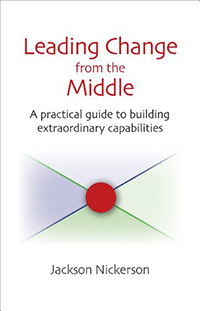With a message today’s management gurus embrace, Benjamin Franklin once wrote, “When you’re finished changing, you’re finished.” But despite the necessity of organizational change, managing for a successful outcome is as tricky as harnessing electricity via kite.

“There are many books on leading change; every consulting firm has a practice on leading change,” said Jackson Nickerson, PhD, the Frahm Family Professor of Organization & Strategy in Olin Business School at Washington University in St. Louis.
“But when efforts to lead change fail 60 to 90 percent of the time, then something is not working. While many books exist on change management, none are positioned for either the special challenges of midlevel leadership or for building extraordinary capabilities,” he said.
Nickerson’s latest book, “Leading Change From the Middle: A Practical Guide to Building Extraordinary Capabilities” (April 24, from Brookings Institution Press), addresses the gap between the desire for change and the ability to pull it off with academic research and practical advice for implementation.
“The point of this book series is to convert the ‘know why’ into the ‘know how,’” said Nickerson, who is also director of Brookings Executive Education and a Brookings nonresident senior scholar in governance studies.
In “Leading Change from the Middle,” Nickerson introduces a new way to think about leading change without authority. His framework employs a unique toolkit and approach to leading organizational change — an approach that has been tested with government executives and professional managers in real organizations.

In presenting this material in a concise, accessible and applicable format that translates theory to practice, Nickerson provides an important service for leaders trying to build extraordinary capabilities for their organizations.
Nickerson shared his thoughts on midlevel leaders, strategies for change and success:
I wrote about midlevel leaders because they often are the ones in the hot seat. While much of the change-management literature focuses on those at the apex of an organization, a lot of change efforts, especially around building new capabilities, are undertaken by those sandwiched in the middle, and there is very little research to guide them.
If you are a midlevel leader, then you are at the crossroads of change, surrounded by four kinds of stakeholders. Above are your superordinates, from whom you must find out how far you can go before you lose their support. Below you are subordinates with whom you must find a way to engage so they feel empowered. With internal and external customers, you must help them understand that the new capability you’re creating adds more value than it costs them to use it. Finally, you must find ways to gain support from complementors and potential blockers, those people who are gatekeepers to resources vital to building the new capability. Leading each stakeholder group requires different communications, strategies, tactics and sequencing — what I refer to as CoSTS — all of which are presented and discussed in the book.
Success in building capabilities is measured not only in getting them up and running but also in doing so without complaints to your manager about your leadership ability. That’s extraordinary.
Editor’s note: Nickerson is available for taped and live-remote radio and television interviews via the university’s broadcast studio, which is equipped with high-definition, broadcast-quality audio (ISDN) and video (vyvx) transmission lines.